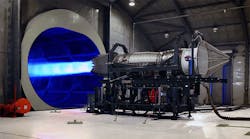Pratt & Whitney has started a new maintenance program it calls a “first… in aerospace propulsion history”, for F119 engines powering U.S. Air Force F-22 Raptor fighter aircraft. The new approach is based on digitally combining flight data with engineering algorithms to plan engine maintenance on an as-needed basis. The engine builder indicated this “usage-based lifing” (UBL) program could save the USAF more than $800 million over the life of the program.
The entire USAF F-22 fleet at Nellis AFB in Nevada has been converted to UBL tracking, and the F-22s at Langley AFB in Virginia are scheduled to start the conversion in March.
UBL is a methodology approved in recent years by the Federal Aviation Authority for Sikorsky S-92 military and civilian helicopters, drawing on historical maintenance data and applying customized algorithms that identify patterns according to how a specific engine has been used, to forecast maintenance schedules for selected components.
The Pratt & Whitney F119 is an afterburning turbofan engine now in its fifth generation. Two F119s power each F-22, and according to P&W one of its advantages is “supercruise, the ability to fly at supersonic speeds without afterburning, which provides the F-22 exceptional combat performance without compromising mission range.”
Noting that engine sustainment budgeting and planning has been carried out largely based on historical data and average mission usage metrics. This means that, without full flight data, engine maintainers can only make assumptions about how the aircraft has been flown and will fly – and that those assumptions are applied to every engine without customizing maintenance to a specific engine’s needs. As a result, engine maintenance might be performed earlier or later than necessary, leading to inefficiencies over the long run.
By incorporating UBL techniques, the USAF and Pratt & Whitney will plan maintenance based on large amounts of real-time data on engine components based on how it is actually being flown, versus an assumed mission mix. This constant flow of data will be re-analyzed continuously and will allow the USAF to take advantage of the full life of the engine – improving readiness and reducing maintenance time and costs.
Pratt & Whitney projected that implementing UBL-based maintenance across the fleet will provide the USAF a model for other engine sustainment programs.






